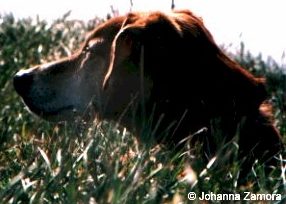|
|
 Jasper and I have known each other since he was born in December 1983. He is a 26
pound neutered male dachshund mix, about the size of a beagle. Just think very big
dachshund! He has always loved to eat, but in 1986 he came down with severe pancreatitis
due to my giving him some fatty foods. He did recover. He has had flare-ups, last one was
in autumn of 1998. Jasper and I have known each other since he was born in December 1983. He is a 26
pound neutered male dachshund mix, about the size of a beagle. Just think very big
dachshund! He has always loved to eat, but in 1986 he came down with severe pancreatitis
due to my giving him some fatty foods. He did recover. He has had flare-ups, last one was
in autumn of 1998.
It  wasn't until January 6, 1996 that he was diagnosed with
diabetes. The prior autumn he began slowing down, but at 11 years old I attributed to age.
In 1994 he did have an episode of drinking and urinating, but nothing serious until
December of 1995. In retrospect, it is obvious that this creeped up on him so slowly that
I barely was able to see it. Finally in December 1995 he was so very weak, so tired and
drinking and urinating a lot. wasn't until January 6, 1996 that he was diagnosed with
diabetes. The prior autumn he began slowing down, but at 11 years old I attributed to age.
In 1994 he did have an episode of drinking and urinating, but nothing serious until
December of 1995. In retrospect, it is obvious that this creeped up on him so slowly that
I barely was able to see it. Finally in December 1995 he was so very weak, so tired and
drinking and urinating a lot.
Stunned and saddened only begin to describe my feelings. Since he was 12 years old, I was
sure he was going to have to be put down. In fact over three years later, he is doing
great. He certainly is an old man now, and I attribute that to the diabetes, but his
attitude is really fabulous.
Initially Jasper began his regime of 2 shots a day on Lilly's Humulin NPH. At first I
never tested, and did not do any bg testing for over 2 years, besides the quarterly
glucose curves. I discovered many things, the hard way: His insulin wasn't making it the
full 12 hours, he fought off regular bladder infections, and seemed to be losing his sight
slowly but surely. In July of 1998 I posted to a newsgroup about canine diabetes asking
about a list or other info. Brenda (of Brenda and Cody) told me about an email list. The
change in my understanding, and Jasper's treatment has been phenomenal.
I began blood glucose testing, which, like for human diabetics, opens a window of
information to help control his disease. BG testing has never been, and still isn't easy
to do. He squirms and fusses. The profound discoveries amazed me: Jasper's insulin doesn't
last a full 12 hours, he tends to get hypoglycemic attacks if I increased it at all to
lengthen it, his peak is 3-5 hours after his injection, he can "eat up" a little
extra insulin with a bigger meal or snacks. All these things have made management much
easier.
A typical day starts with 9 units of insulin at any time between 9 a.m. and Noon,
depending on my schedule. Eating breakfast before I inject him is paramount, it tells me a
lot of things: is he still low from last night, is he really hungry, is he "off"
his food. A blood test will support this, and a call to the vet if he seems to be doing
poorly. I will give him things to enhance the flavor of his food - he generally tends to
not like breakfast - low fat and low carbohydrate if I can help it. His latest
favorites are: soy
"fake meat" crumbles, broiled chicken and fat free chicken broth. Small amounts
get him to nose into his food. At the 4-5 hour mark Jasper eats his largest meal, which
coincides with the peaking of his insulin. At around 7-10 p.m. (approximately 9-11 hours
after the a.m. injection, though usually never more than 10 hours between injections) I
give him his final injection of 7-8 units. How do I decide? I blood test him, I see how
much he has eaten all day, if he wants more food, or if he is tired from more than normal
exercise. The 14 hours at night before he eats again seems long, but for him it is not.
When I first started out I did the 12 hour injections religiously, he did get very weak
over night. Somehow the longer time lets the insulin work just right, by morning he is in
a good range and ready for the day.
Due to years of poor regulation, he has lost about 70 - 80% of his sight. I had been told
by the vet for years before he was diagnosed that his sight was failing, but Jasper belied
that with amazing capabilities. Perhaps now he does the same. He can't see well at night,
but during the day he does pretty well. Another couple of things: He still fights off
low-grade infections, and we are still working on preventing those. He had some back
trouble in 1996, which though cured, seems to have left some sort of tiny palsy in one
back leg. It is effected by his blood sugar levels, that is sometimes the weakness in his
hindquarters is more evident, especially if glucose levels are very low. Jasper takes
Anipryl for canine dementia. This just started a month ago, but the difference is very
noticeable. Since the "doggy dementia" can also effect his muscle coordination,
it is hard to pin what causes the hindquarter weakness. And finally: Jasper just had his
teeth cleaned about 2 weeks ago. He did very well and lost no teeth. Hooray!
He is my oldest and dearest friend. As with most diabetic pets, he cannot tell me if he is
feeling nauseated or hungry or weak. I have to keep an eagle eye on him. I managed a
stable several years ago and learned that the subtleties are where the deepest information
hides. I wish I had known that I had so many more options when I saw the way the
initial
treatment wasn't working. I owe so much to the list, possibilities were opened up that I
didn't know were there. Jasper just had his 15th birthday on Dec. 6, 1998. He still goes
camping. Still jumps up when I get home, still looks forward to meals, walks and sneaking
cat food. On the list of leading indicators, he is enjoying life. A lot.
On March 10, 2000 I lost Jasper to old age. It has been very hard, because he was a dear friend. I hope that anyone who faces this disease with their pet realizes that it can be dealt with. That you can have very good years after diagnoses.
++++++
I miss you old friend"
-- Contributed by Johanna and Jasper Julep Longtail

  



Contributed May 2000
Copyright. All rights reserved.
This site is for information purposes only. Please consult
your veterinarian. |
 Jasper
Julep Longtail's Story
Jasper
Julep Longtail's Story Jasper
Julep Longtail's Story
Jasper
Julep Longtail's Story